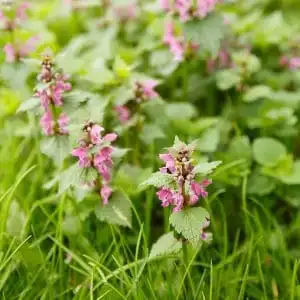Members of the mint family, henbit (Lamium amplexicaule) and purple deadnettle (Lamium purpureum) are so similar in appearance and behavior that they are often mistaken for each other. These two winter annuals both produce tiny purplish flowers that bloom in early spring. But the biggest similarity is that these uninvited guests are apt to spread quickly and take over your landscaping. Native to Europe and Asia, these common weeds are now found in North America, and even deemed invasive in some areas. Learn more about henbit and purple deadnettle.
Common Traits of Henbit and Purple Deadnettle
Henbit and purple deadnettle thrive in areas such as gardens, fields, and thinning lawns where the soil has been disturbed. As other members of the mint family, these weedy plants have squared stems. They are winter annuals, so they begin their life cycle in the fall, forming leaves that last through winter, and begin their reign in early spring. This makes them a crucial source for pollinators. After setting seed in late spring or early summer, they eventually turn yellow and wither. The plants bide their time for the cooler days of fall to reemerge. Henbit and purple deadnettle grow low to the ground and feature delicate, purplish-pink flowers.
Differences Between Henbit and Purple Deadnettle
Although these weeds seem similar, there are ways to tell them apart.
Purple Deadnettle
- Groups of four to six flowers at the stem top.
- Leaves are slightly pointed, veiny, get gradually smaller toward the top. They are attached to the main stem with tiny, short stems.
- Upper leaves are tinged with red or purple.
- Each plant can produce more than 20,000 seeds.
Henbit
- Flowers are more sparse and tube-like in appearance.
- Leaves are circular with little veining, attached directly at the stem top, and slightly smaller than purple deadnettle.
- Stems are usually darker and more reddish.
- Each plant can produce up to 2,000 seeds.
Henbit and Purple Deadnettle Management
Don’t be fooled by the pretty carpet of purple flowers these weeds produce in early spring. Once established, they are a challenge to eradicate. They generate thousands of seeds that can remain in the soil for years.
Put down pre-emergence herbicides to control these winter annuals in late summer or fall before the seeds germinate. If you are already plagued by them, you’ll need a post-emergence herbicide. Hand weeding works only if you get to them before they set seed and if you only have a small amount of plants.
As with most weeds, a lush healthy lawn is your best defense against henbit and purple deadnettle. Hardy, dense turf leaves little room for weeds to grow, so maintain your lawn regularly with proper mowing height, fertilization, and watering.
For more information on controlling weeds, contact Free Spray Lawn Care at 419-529-5296.



Comments (0)
Thanks for your comment!
Thanks for your feedback! Your comments have been successfully submitted! Please note, all comments require admin approval prior to display.
Error submitting comment!
There is a problem with your comment, please see below and try again.